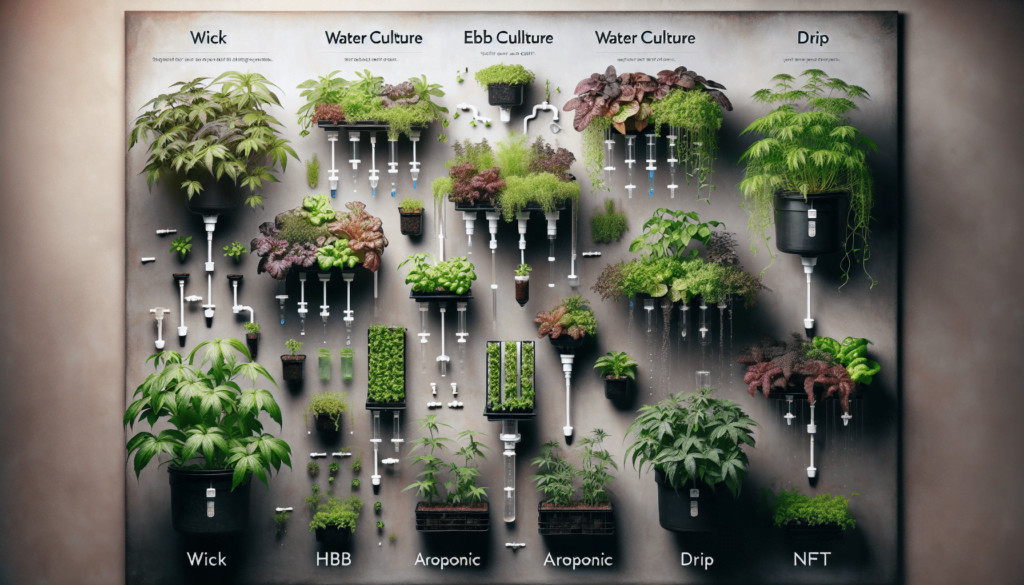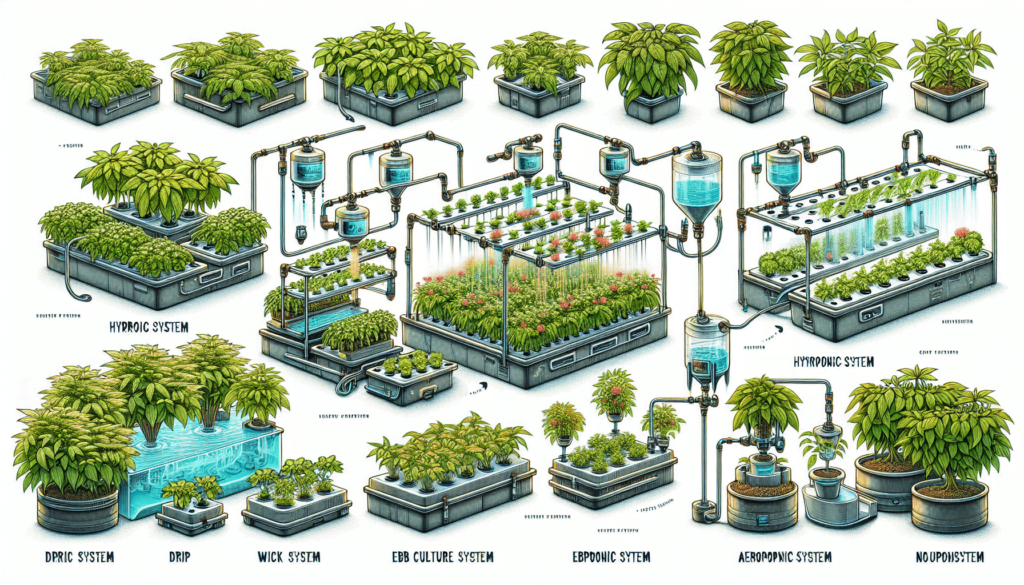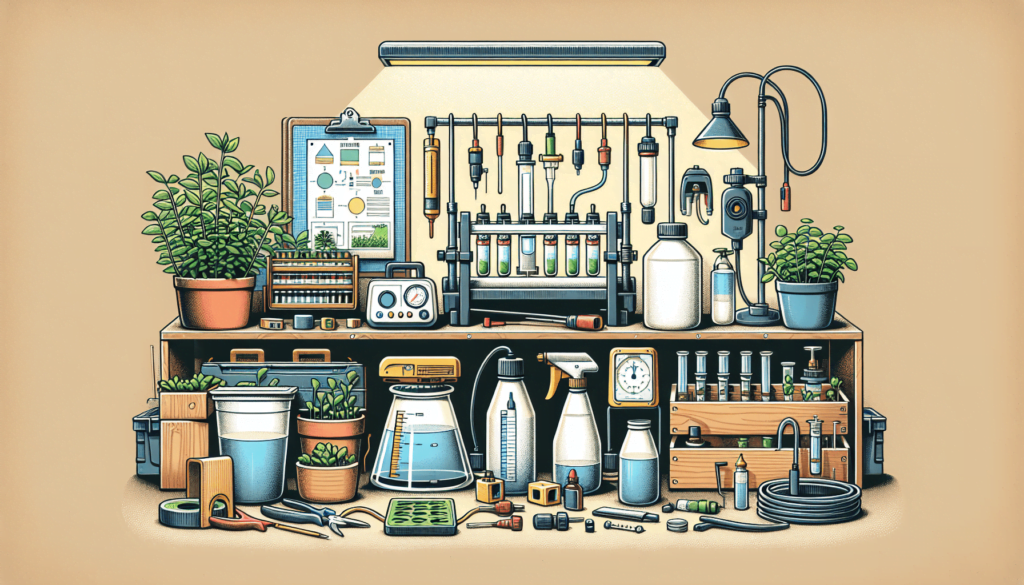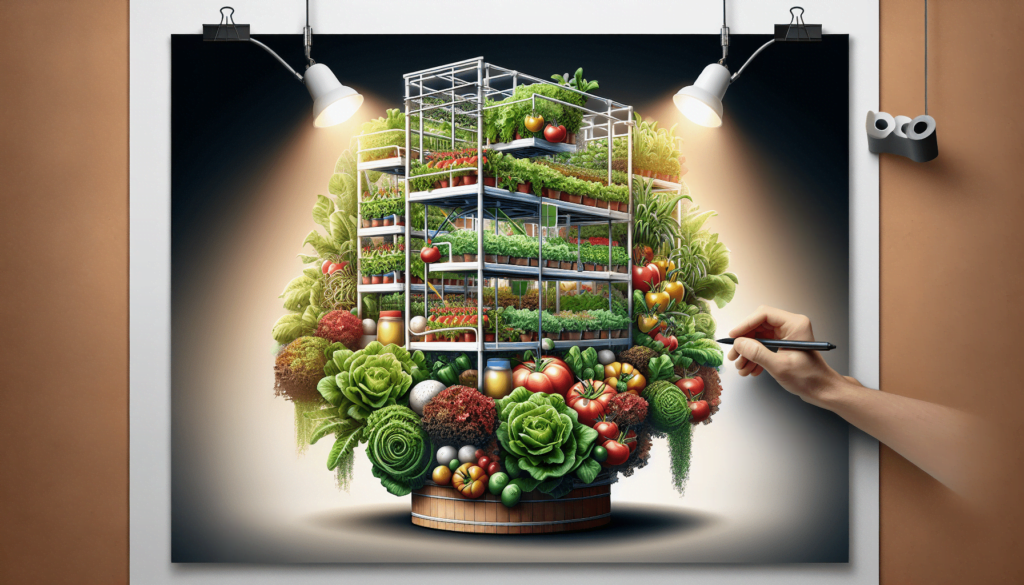Us gardening enthusiasts can’t help but feel delighted when we come across innovative methods that not only allow us to cultivate a variety of plants but also make the process efficient and space-friendly. One such method is Hydroponics, a soil-less plant cultivation technique that has been turning heads for all the right reasons. If you happen to be a novice gardener looking to explore this intriguing world of hydroponics, then you’ve landed in a valuable location. This article provides you with insightful ideas for setting up your hydroponic garden, tailored especially for beginners. So, let’s get started on these top 10 interesting hydroponic setup ideas that are perfectly curated for young buds like you.
Deep Water Culture (DWC) System
Deep Water Culture, commonly referred to as DWC, is a hydroponic technique where plants are suspended in a specially made net-pot. These pots are filled with a growing medium that supports the roots of the plants and allows the roots to access a nutrient-rich water solution directly. The principle behind the DWC system is that it provides plants with an abundant supply of oxygenated water which greatly accelerates growth rate.
Understanding the DWC hydroponic system
In a DWC hydroponic system, the plants are literally floating on the surface of the water with their roots stretching into the water to access the nutrients. The water is heavily oxygenated, with an air pump providing a constant supply of bubbles. This unlimited access to oxygen, coupled with the easy availability of water and nutrients, allows plants to grow at an almost unprecedented rate in DWC systems.
Choosing the right equipment for DWC
When setting up a DWC system, there are a few vital pieces of equipment you need to consider. An air pump and air stone are key to provide the necessary oxygen for the plant roots. To house your plants, you’ll need a waterproof container or reservoir, such as a bucket or large plastic tub. And don’t forget the net pots and a suitable hydroponic growing medium!
Benefits and drawbacks of DWC
The most significant advantage of DWC is the exponential growth rate you can achieve. However, it requires constant power to maintain the air pump and can be a bit high-maintenance compared to other systems. Power outages can be absolutely catastrophic in DWC systems, as without the air pump, the water can quickly become deoxygenated and jeopardize the life of the plants.
Wick System
The Wick system is arguably the simplest form of hydroponics. It’s passive, meaning it doesn’t require any electricity, making it great for beginners or those looking to experiment with hydroponics without investing too much at first.
Understanding the Wick hydroponic system
In Wick system, a plant is grown in a container or pot with a nylon wick connected to a reservoir of nutrient-rich water. The wick acts like a straw, drawing the water up to the plant’s roots.
Setting up a Wick system at home
To set up a Wick system at home, you need a few simple components: a growing medium, a reservoir, growing containers, and wicks. The wicks can be materials such as nylon ropes or even strips of cloth. This system is easy to assemble as it mainly involves arranging the wicks such that they draw water from the reservoir, up to the growing containers.
Pros and cons of the Wick system
The Wick system is one of the most affordable and easiest to set up, perfect for beginners. However, it’s rare to achieve the same growth rates as you would with more advanced systems like DWC or NFT. Also, larger, more thirsty plants may outpace the wick’s ability to supply water and nutrients.

Nutrient Film Technique (NFT) System
A more advanced form of hydroponics, the Nutrient Film Technique (NFT) involves a constant flow of nutrient solution over the roots of plants, which are held in small net pots, suspended within a sloping system of channels.
Basic principles of the NFT system
Fancy as it sounds, the main idea behind NFT is relatively simple. It consists of a flow of nutrient-rich solution that cascades down a slight incline. A pump pushes the water through from the top, then it’s captured at the bottom in a reservoir to be recirculated.
Creating a DIY NFT system
To set up a NFT system at home, you’ll need PVC pipes or similar plant channels, a reservoir, a water pump, and net pots. The most important part of this system is arranging the pipes at a slight angle to allow the nutrient solution to flow down uniformly.
Potential challenges with NFT systems
While NFT systems can provide excellent growth rates, they come with challenges. They are more complex to set up and maintain compared to a Wick or DWC system, and power failures could result in drying out and potentially killing the plants as the flow of nutrients is interrupted.
Ebb and Flow System
The Ebb and Flow system, also known as flood and drain, is a versatile hydroponic system, perfect for multiple plants and various sizes. It’s better suited for plants that require a dry period because it allows control over flooding intervals.
Discovering the Ebb and Flow hydroponic system
This system works by temporarily flooding the grow tray with nutrient solution, which then slowly drains back into the reservoir. This action oxygenates the roots and helps them uptake nutrients efficiently.
Steps to build an Ebb and Flow system
To build an Ebb and Flow system, you’ll need a reservoir, a grow tray, a water pump, and a timer. The pump fills the grow tray with nutrient solution at intervals set by the timer, and then the solution flows back into the reservoir.
Challenges and advantages of Ebb and Flow
While the Ebb and Flow system is great for plants that like a dry period, it can be a bit tricky to set the correct timing intervals for watering. On the other hand, it supports a wide variety of plants, and customization to suit different plants is quite easy.

Aeroponics System
An aeroponics system is a more high-tech type of hydroponics. Plants are suspended in air, with their roots exposed to a nutrient-rich mist. This allows roots to uptake large amounts of oxygen, promoting rapid growth.
Understanding the concept of aeroponics
Powerful sprayers atomize the nutrient solution into tiny droplets, which are then sprayed directly onto the roots of the plants. This results in a high oxygen uptake and very rapid growth.
How to build an aeroponics system
Building an aeroponics system requires a slightly different type of equipment compared with other hydroponic systems. While you still need a reservoir and a pump, you’ll also need misters or sprayers, a low-pressure timer, and a high-pressure pump.
Considerations for maintaining an aeroponics system
Aeroponics systems demand a lot of attention. Failure of pump or sprayers can lead to roots drying out. They generally consume more electricity due to the need for high-pressure pumps. However, the outcome is rewarding as they can offer some of the fastest growth rates in the hydroponics realm.
Drip System
The Drip system, another popular hydroponic system, combines the simplicity of the Wick system with the robust yield potential of systems like DWC.
Exploring the Drip Hydroponic system
Drip systems work by slowly delivering nutrient solution directly to the base of each plant via a network of tubes. It allows for efficient use of nutrients and water.
Building a simple Drip system at home
The setup for a Drip system at home involves a timer, water pump, reservoir, and tubes for each plant. The most labor-intensive part of setting up a Drip system is installing the drip lines for each plant.
Considerations for running a Drip system
While Drip systems are efficient and customizable, they can be a bit more challenging to set up than simpler systems. Over time, mineral deposits can clog the drip lines. However, they’re great for saving water and nutrients and can support large, high-yield gardens.
Fogponics System
Fogponics takes the logic of aeroponics a step further by using high-pressure systems that atomize the nutrient solution to even smaller mist particles, forming a sort of nutrient-rich fog.
Learning about Fogponic Hydroponic system
Similar to aeroponics, plants are suspended in air with their roots exposed to the misty nutrient solution. The difference lies in the size of the liquid particles. In Fogponics, water droplets are minuscule, allowing for better absorption and faster plant growth.
Steps to establish a Fogponics system
Setting up a Fogponics system follows the same basic principles as an aeroponic system. You’ll need a reservoir, high-pressure pumps, and foggers to create the nutrient fog.
Benefits and challenges of Fogponics approach
The biggest benefit of Fogponics is the very high oxygen absorption which leads to rapid plant growth. Nonetheless, foggers are prone to clogging, and rudimentary systems may lack the feedback mechanisms to keep roots adequately moistened.
Dutch Bucket System
The Dutch Bucket system, or Bato buckets, is versatile, easy to scale and is a popular choice for growing larger plants like tomatoes or cucumbers hydroponically.
Understanding Dutch Bucket method
In a Dutch Bucket system, buckets are filled with a growing medium like perlite or coconut coir. A small amount of nutrient solution is continuously dripped into each bucket, which then drains out, taking with it any unused nutrients or salts.
Building your own Dutch Bucket system
The primary components you’ll need for a Dutch Bucket system are buckets, a reservoir, a water pump, a drip irrigation system, and a suitable growing medium.
Challenges and advantages of using Dutch Bucket system
The Dutch Bucket system is highly scalable and versatile. However, it can be labor-intensive and requires some skills for setting up the irrigation system right. On the upside, it’s excellent for long-term crops like fruits or vines.
Vertical Hydroponic System
Vertical hydroponic systems are great for small spaces. They take advantage of vertical space, allowing for much higher yields per square foot compared to traditional, horizontal systems.
Introduction to Vertical hydroponic systems
Vertical systems function by stacking growing containers vertically, allowing gravity to help with the delivery of the nutrient solution. One example of a vertical system is the Tower Garden.
Steps to create a Vertical hydroponic setup
To create a Vertical hydroponic system, you’ll need a tall, upright structure for mounting pots, a water pump, tubing to distribute water to the top pot, and a drip mechanism to trickle water down to all the pots below.
Pros and cons of Vertical systems
The main advantage of a Vertical system is it saves a lot of space. However, getting adequate light to all plants can be tricky as those at the bottom might be shaded by those above. Waterspouts or leaks can also be problematic due to gravity.
Aquaponics System
Aquaponics is a sustainable circular system combining hydroponics with aquaculture (fish rearing). Fish waste provides nutrients for the plants, and the plants filter the water for the fish.
Combining hydroponics and aquaculture in Aquaponics
In an Aquaponics system, water from a fish tank is pumped into a plant bed where beneficial bacteria break down fish waste into nitrates, essential for plant growth. The water is then circulated back into the fish tank.
Building a basic Aquaponics system
To build an Aquaponics system, you’ll need a fish tank, a grow bed or pots for plants, a water pump and of course, fish! The choice of fish can depend on your local climate, with tilapia being a common choice due to hardiness and growth rate.
Benefits and limitations of Aquaponics
Aquaponics can be a delightful and very eco-friendly way of farming. It does, however, require a bit of learning and balancing to maintain optimum water pH and temperature for both fish and plants. Plus, it’s not the best choice for quick yields, since you’ll need to wait for the fish to produce enough waste before you start seeing significant plant growth.
Hydroponics can help revolutionize the way we grow plants, but choosing the right system takes a bit of knowledge and preparation. We hope this guide provides a great starting point for any novices looking to embrace this fascinating and rewarding approach to gardening. Happy growing!
Forum
Got something to share or a question to ask? Jump in and start a conversation! Whether it’s tips, advice, or just sharing your experiences, we’d love to hear from you. Don’t be shy—your input could inspire or help someone else!- This forum has 1 topic, and was last updated 10 months, 2 weeks ago by .
- Topic
- Voices
- Last Post
- You must be logged in to create new topics.


